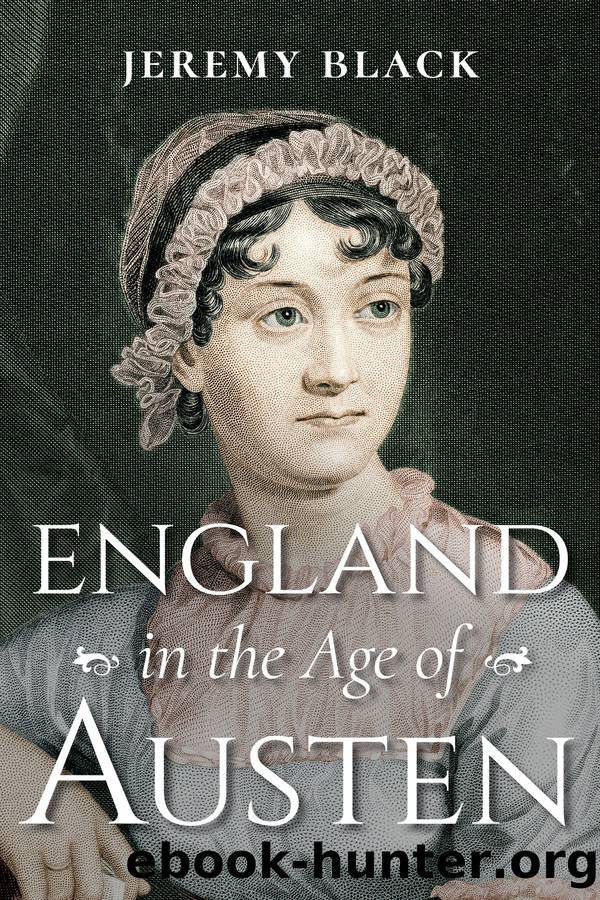England in the Age of Austen by Jeremy Black

Author:Jeremy Black
Language: eng
Format: epub
ISBN: 9780253051967
Publisher: Indiana University Press
Published: 2020-10-21T00:00:00+00:00
And with regard to their influencing public manners, Miss Crawford must not misunderstand me, or suppose I mean to call them the arbiters of good breeding, the regulators of refinement and courtesy, the masters of the ceremonies of life. The manners I speak of might rather be called conduct, perhaps, the result of good principles; the effect, in short, of those doctrines which it is their duty to teach and recommend; and it will, I believe, be every where found that as the clergy are, or are not what they ought to be, so are the rest of the nation.35
London helped mold a national economic space, although it is clear that specialization for the London market was accompanied by the persistence of more local economic patterns. Most of the food for Londonâs growing population came from within Britain, and even more so within England itself, far more so than today, and the prices in London were printed in provincial newspapers. The prime agricultural market for all aspects of Austenâs rural world was London. Animals for the London market, such as turkeys from Norfolk, were âdrivenââin other words, walkedâacross southern England. Similarly, beef cattle were driven from Scotland, Wales, and northern England.
Moreover, London finance was important to the rest of the country. An interregional credit structure based on London was established, ensuring that local economies were very much linked to the situation in London, as well as to each other via London. In 1775, the establishment of a bank clearinghouse in Lombard Street in the city led to a great improvement: banks were allowed to balance credits and withdrawals by a ticket system. London-based insurance companies operated across the country through agents. Mr. Heywood goes to London twice yearly in order to receive his dividends.36 Proximity to the capital was a key element in appeal, with Mr. Parker praising Sanditon as a bathing place for having âthe most desirable distance from Londonââit was a mile closer than Eastbourne. In practice, each was in competition with Brighton as a Sussex resort. The wealth of the city is captured in Lucy Steeleâs description of Mr. Richardson: âHe makes a monstrous deal of money.â37
London publications spread designs while London craftsmen were in demand across the country. Bright provincials such as Thomas Sheraton went to London and had their ideas and talents validated there. The literary equivalent included works such as Charles Vyseâs New London Spelling Book (1776). The norms of the language were set in London by these and other methods and books, which, in turn, were advertised in provincial newspapers. Talented foreigners also visited London. Josef Haydn went there in 1791 and 1794 to give very successful public concerts for which he wrote his London symphonies.
Metropolitan influence, however, did not prevent autonomous developments elsewhere in Britain. Thus, provincial silversmiths, such as those in Exeter, were influenced by London designs but also produced works with unique features. The provinces had the capacity both to preserve local practices and take initiative. At the same time,
Download
This site does not store any files on its server. We only index and link to content provided by other sites. Please contact the content providers to delete copyright contents if any and email us, we'll remove relevant links or contents immediately.
| Africa | Americas |
| Arctic & Antarctica | Asia |
| Australia & Oceania | Europe |
| Middle East | Russia |
| United States | World |
| Ancient Civilizations | Military |
| Historical Study & Educational Resources |
Magic and Divination in Early Islam by Emilie Savage-Smith;(1197)
Ambition and Desire: The Dangerous Life of Josephine Bonaparte by Kate Williams(1087)
Operation Vengeance: The Astonishing Aerial Ambush That Changed World War II by Dan Hampton(986)
What Really Happened: The Death of Hitler by Robert J. Hutchinson(871)
London in the Twentieth Century by Jerry White(848)
Time of the Magicians by Wolfram Eilenberger(844)
Twilight of the Gods by Ian W. Toll(813)
The Japanese by Christopher Harding(803)
Papillon by Henry Charrière(796)
Lenin: A Biography by Robert Service(780)
The Devil You Know by Charles M. Blow(779)
Twelve Caesars by Mary Beard(769)
Freemasons for Dummies by Hodapp Christopher;(749)
The Churchill Complex by Ian Buruma(731)
Napolean Hill Collection by Napoleon Hill(706)
The Enlightenment by Ritchie Robertson(693)
Henry III by David Carpenter;(690)
Bohemians, Bootleggers, Flappers, and Swells: The Best of Early Vanity Fair by Bohemians Bootleggers Flappers & Swells- The Best of Early Vanity Fair (epub)(688)
The Rise and Triumph of the Modern Self by Unknown(659)
